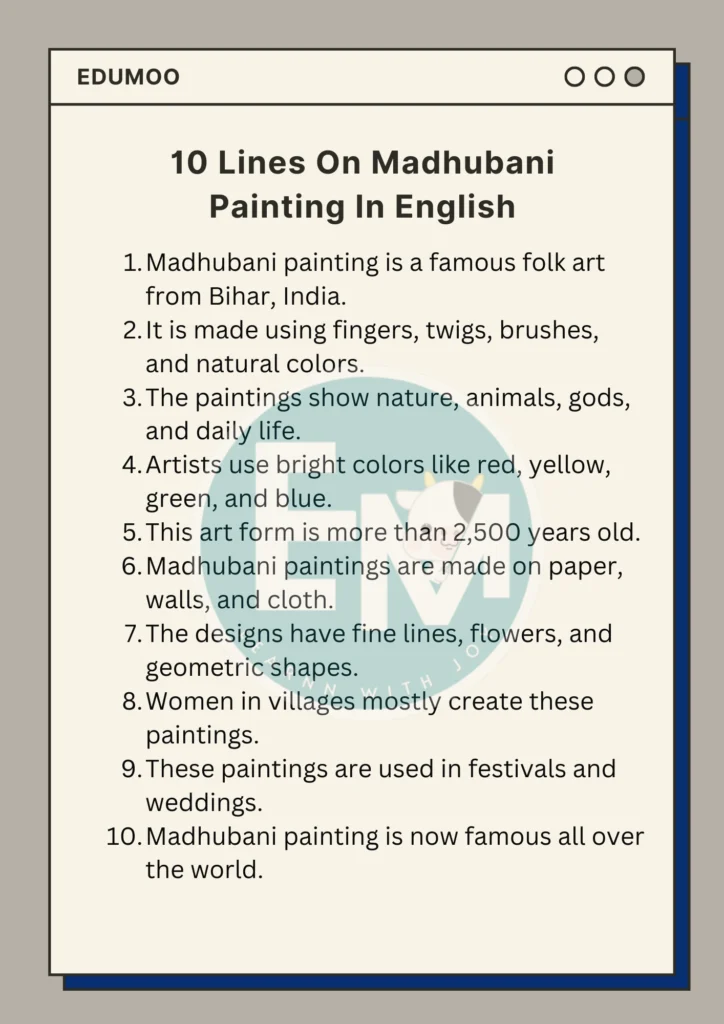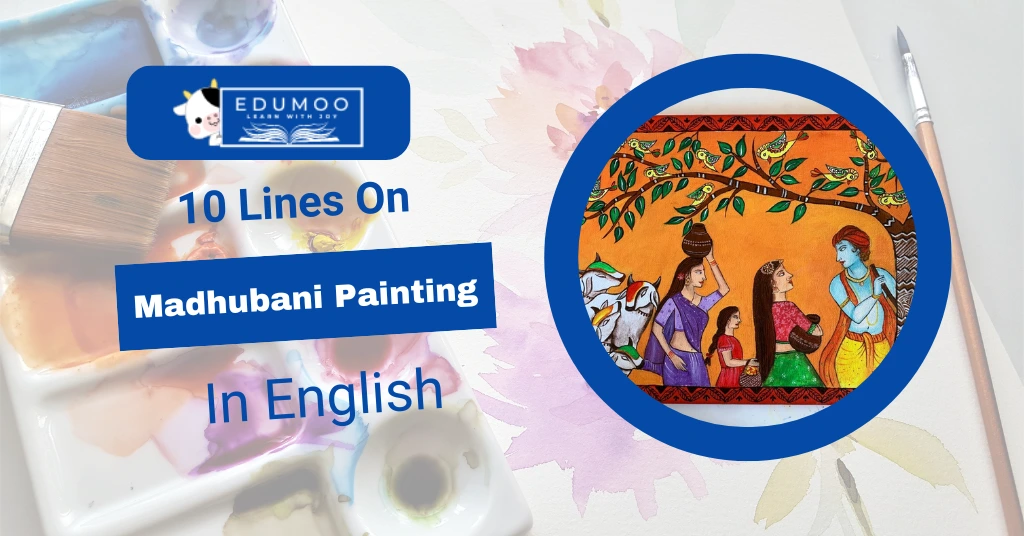Madhubani painting is a traditional folk art from Bihar, India. It is known for its bright colors and unique patterns. People make these paintings using natural colors and handmade brushes. The designs mostly show nature, gods, animals, and special events like weddings. This art form is very old and has been passed down for generations. Women in villages mostly create these beautiful paintings. They decorate walls, cloth, and paper with them. The artwork has fine details and looks very colorful. Today, Madhubani painting is famous worldwide. Let’s learn more about it in 10 lines on madhubani painting.
10 Lines On Madhubani Painting In English
- Madhubani painting is a famous folk art from Bihar, India.
- It is made using fingers, twigs, brushes, and natural colors.
- The paintings show nature, animals, gods, and daily life.
- Artists use bright colors like red, yellow, green, and blue.
- This art form is more than 2,500 years old.
- Madhubani paintings are made on paper, walls, and cloth.
- The designs have fine lines, flowers, and geometric shapes.
- Women in villages mostly create these paintings.
- These paintings are used in festivals and weddings.
- Madhubani painting is now famous all over the world.

Essay On Madhubani Painting In English In 300 Words
Madhubani painting is a well-known folk art from the Mithila region of Bihar, India. It is famous for its bright colors, detailed patterns, and cultural significance. This art form is believed to be more than 2,500 years old. It is said that Madhubani paintings were first made during the wedding of Lord Rama and Sita. Since then, people have been creating these beautiful paintings for different occasions.
The artists use natural colors made from flowers, leaves, and turmeric. They do not use modern brushes; instead, they paint with fingers, twigs, and matchsticks. The paintings mostly show nature, gods, animals, and everyday life scenes. The designs include fine lines, floral patterns, and geometric shapes. The bright colors like red, yellow, blue, and green make the paintings look very attractive.
Traditionally, women in villages used to make these paintings on the walls of their homes. With time, Madhubani painting became popular, and now it is made on paper, cloth, and even canvas. Many artists have taken up this art and shared it with the world. Today, it is an important part of Indian culture and is loved by people worldwide.
Madhubani paintings are used in festivals, weddings, and religious events. They are also given as gifts and used as home decorations. The government and many art organizations are working to preserve this beautiful tradition. Many young artists are learning this art to keep the tradition alive.
Madhubani painting is not just an art form; it is a way of storytelling. Each painting has a deep meaning and tells a unique story. The bright colors and traditional designs make it special. Learning about Madhubani painting helps us appreciate India’s rich cultural heritage. It is important to protect and promote this beautiful art so that future generations can enjoy its beauty.
Essay On Madhubani Painting In English In 650 Words
Madhubani painting, also known as Mithila art, is a traditional folk art form that originated in the Mithila region of Bihar, India. This unique style of painting is characterized by its intricate patterns, vibrant colors, and deep cultural significance. Historically, Madhubani paintings were created by women on the freshly plastered walls and floors of their homes during festivals, weddings, and other significant events. Over time, this art form has transcended its humble beginnings to gain international recognition.
The origins of Madhubani painting are deeply rooted in the cultural traditions of the Mithila region. According to legend, King Janak of Mithila commissioned artists to create paintings to celebrate the marriage of his daughter, Sita, to Lord Rama. This event is often cited as the inception of this art form. Traditionally, the knowledge and skills required for Madhubani painting were passed down through generations of women, making it an integral part of the domestic and cultural life of the community. The paintings often depicted themes from nature, mythology, and daily life, reflecting the artists’ surroundings and beliefs.
One of the most distinctive features of Madhubani painting is its use of natural materials. Artists traditionally used natural dyes and pigments derived from plants and other organic sources. For instance, green was obtained from bel leaves, orange from palash flowers, and red and yellow from turmeric and pollen. The colors were then applied using simple tools such as fingers, twigs, and brushes made from bamboo sticks. This reliance on natural materials not only gave the paintings their characteristic earthy aesthetic but also underscored the community’s connection to nature.
Madhubani paintings are rich in symbolism and often depict themes from Hindu mythology, nature, and daily life. Common subjects include deities like Krishna, Rama, and Durga, as well as elements such as the sun, moon, and sacred plants like the tulsi. The paintings are characterized by their eye-catching geometrical patterns and often leave no space empty; the gaps are filled with motifs of flowers, animals, birds, and even geometric designs. This dense composition reflects the artists’ desire to convey a sense of abundance and auspiciousness.
While Madhubani painting began as a form of domestic decoration, it has evolved significantly over time. In the 1960s, a severe drought in the Mithila region led to economic hardship, prompting women to transfer their wall paintings onto paper and canvas for sale. This adaptation not only provided a source of income but also introduced Madhubani art to a wider audience. Today, Madhubani paintings are celebrated globally and are featured in art galleries and exhibitions around the world. The art form has also been used in various social and environmental campaigns. For instance, in 2012, local artists painted trees with Madhubani motifs to prevent deforestation, as the sacred images discouraged people from cutting them down.
Efforts to preserve and promote Madhubani painting have been undertaken by various organizations and individuals. Institutions such as Kalakriti in Darbhanga and Gram Vikas Parishad in Ranti have played significant roles in keeping this ancient art form alive. These organizations provide training and support to artists, helping them to sustain their livelihoods and continue the tradition. Additionally, the Indian government has recognized the cultural importance of Madhubani painting by granting it Geographical Indication (GI) status, which helps protect the authenticity and originality of the art form.
Madhubani painting is more than just an art form; it is a vibrant expression of the cultural heritage of the Mithila region. Its intricate designs and vivid colors tell stories of mythology, nature, and daily life, reflecting the worldview of the artists. The evolution of Madhubani from wall murals to a globally recognized art form underscores its adaptability and enduring appeal. As efforts to preserve and promote this tradition continue, Madhubani painting remains a testament to the rich artistic legacy of India.
Conclusion
Today, we have learnt 10 lines on Madhubani Painting. Madhubani painting is a beautiful and creative art form from India. It shows the rich culture and traditions of Bihar. The bright colors and detailed designs make it special. This folk art has been loved for many years and is still practiced today. Many people around the world admire and learn this painting style. Learning about Madhubani painting helps us understand India’s rich heritage.

